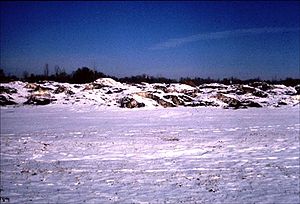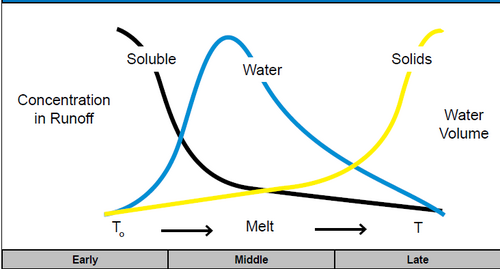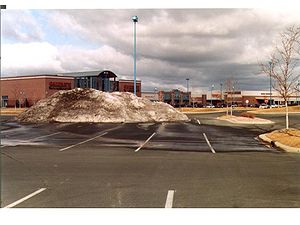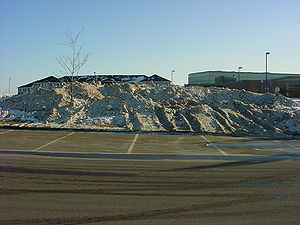
Guidance and recommendations for storing transported snow and for on-site snow storage
This page provides recommendations for managing and storing snow. It includes information for snow collected from impervious surfaces and transported to a storage location as well as information on storing snow on-site. The recommendations focus on protection of surface waters (lakes, rivers, wetlands), except where otherwise noted.
NOTE: This page only provides a general overview of snowmelt dynamics, instead focusing on snow storage. Numerous references are included throughout this page and the reader is referred to those for more detailed information. This manual also has a page on Cold climate impact on runoff management which provides a comprehensive discussion of cold climate considerations for managing urban stormwater and stormwater practices, including information on snowmelt runoff and snow management.
Contents
Dynamics of snowpack melt
Snow packs experience multiple freeze-thaw cycles through the winter and early spring. This results in partial melting and channelized flow of meltwater in the snowpack. Soluble pollutants are preferentially transported with this meltwater and accumulate near the base of the snowpack, while particulates are filtered during these partial melts. This accounts for the high release of soluble pollutants in the early phases of the melt.
Oberts (2010) described a three stage melt process in urban areas.
- The first melt stage involves melting from paved areas. If this snow and ice contains deicers, the resulting meltwater is very saline water and also carries accumulated road pollutants into drainage systems and local receiving waters. If snow from these paved areas is collected and moved to a storage location, meltwater from these storage piles may contain high levels of soluble pollutants such as chloride, phosphorus, and some metals, as well as elevated biochemical oxygen demand.
- The second melt stage involves the gradual melt of snow piles adjacent to road surfaces. This melt is similar to initial melting in stored snow piles, where initial chemical concentrations of soluble pollutants is relatively high, while sediment-bound pollutant concentrations are low.
- The final stage of the snowmelt is the melt of pervious areas, such as grassed lawns. Chemical concentrations are typically lower but may be dominated by sediment and sediment-bound pollutants if the melt occurs quickly, as would occur with warm temperatures and/or rain falling on the snowpack.
Characteristics of snowmelt
Link to this table
| Early | Middle | Late | X |
|---|---|---|---|
| Character | |||
| High soluble content | Remaining solubles, beginning of fine- to medium-solids | High solids content | |
| Low runoff volume, early infiltration | Large runoff volume | Large runoff volume (especially if rain-on-snow occurs), saturated soils | |
| Initiated by chemical addition and/or solar radiation | Largely driven by solar radiation, aided by salt | Solar driven | |
Water quality and chemistry of snow and snowmelt runoff
The quality of runoff from melted snow is affected by the dynamics of snowmelt. The following information was extracted from the literature.
- Initial meltwater is acidic and contains a higher percentage of soluble pollutants compared to later meltwater. The initial melt may comprise only 30% of the total volume but contain 60-90% of the total phosphorus and nitrogen released from the entire melt. Johannessen and Henriksen (1978) found in both laboratory and field studies that about 40 to 80% of 16 pollutants were released from experimental snowpacks with the first 30% of the liquid melt. Pollutant concentrations in the initial melt are typically 2 to 2.5 times greater than those in the remaining snowpack.
- Street loads of sediment and toxic materials are at an annual peak at the onset of winter melt and early spring rainfalls.
- The last period of melting contains lower concentrations of pollutants and is dominated by particulates and associated pollutants.
Water quality of snowmelt differs from non-winter runoff.
- Data from Capital Region Watershed District (CRWD) indicates total phosphorus concentrations are similar (medians of 0.325 and 0.304 mg/L for snowmelt and non-snowmelt runoff, respectively), but concentrations are more variable in winter runoff (mean concentrations of 0.412 and 0.289 mg/L, respectively).
- CRWD data shows higher concentrations of dissolved phosphorus in snowmelt compared to non-winter runoff (0.119 and 0.053 mg/L, respectively). Thus, dissolved phosphorus comprises about 35% of total phosphorus in snowmelt but only about 20% of total phosphorus in non-winter runoff.
Recommended references
- Bratt, Anika R., Jacques C. Finlay, Sarah E. Hobbie, Benjamin D. Janke, Adam C. Worm, and Kathrine L. Kemmitt. 2017. Contribution of Leaf Litter to Nutrient Export during Winter Months in an Urban Residential Watershed. Environ Sci Technol 51(6):3138-3147. doi: 10.1021/acs.est.6b06299.
- Oberts, Gary L. 2000. Influence of Snowmelt Dynamics on Stormwater Runoff Quality. Metropolitan Council, St. Paul, MN. Watershed Protection Techniques. 1(2): 55-61.
Recommendations for storage of snow transported to a snow storage location
This section provides guidance and recommendations for managing snow from impervious surfaces that is transported (trucked) to a snow storage area, where the snow is stockpiled and allowed to melt. The guidance includes information on identifying appropriate snow storage areas, storing snow in those areas, and operations and maintenance of snow storage areas.
Environmental significance of stored snow
Snow may be removed from an impervious surface for several reasons, including but not limited to the following.
- Safety concerns
- Accommodate transportation
- Minimize potential damage to infrastructure
- Minimize or prevent drifting
- Reduce flooding concerns
- Space limitations
- Environmental concerns
Snow removed from an impervious surfaces contains a variety of pollutants, including sediment, coarse organic material, nutrients, chloride, metals, and hydrocarbons. Melted snow may create an oxygen demand and have other impacts on water quality, such elevated or reduced pH. These pollutants can impact receiving waters.
The previous discussion on dynamics and water quality impacts of snowmelt are applicable to meltwater from a snow storage area. The table below provides a general summary of pollutants associated with different source areas for the snow.
In addition to water quality concerns, improperly managed snow can lead to water quantity issues, such as flooding and erosion.
Regulatory implications
There are no specific regulatory requirements regarding snow storage in NPDES stormwater permits. Proper snow storage may facilitate meeting NPDES requirements. For example, snow storage may result in pollutant load reductions to impaired waters having approved total maximum daily loads.
The next section provides a discussion of potential restrictions for snow storage.
Siting recommendations
For more information, see [1], [2], [3], [4], [5], [6], [7]. |
Considerations
- Identify receiving waters and assess the risk to them. Although identifying the contribution of baseflow to receiving waters can be challenging, it is important if meltwater will infiltrate and recharge groundwater. Potential receiving waters include the following.
- Streams and rivers with a significant baseflow component
- Streams and rivers with low baseflow component
- Lakes and wetlands with a baseflow component
- Lakes and wetlands with limited baseflow
- Groundwater
- Special waters - identify receiving waters with temperature-sensitive species (e.g. trout)
- Impaired waters - identify impaired waters and the pollutant(s) of impairment
- Consult with your local community or municipality for technical guidelines on snow site management and operations.
- Estimate how much snow disposal capacity is needed for the season so that an adequate number of disposal sites can be selected and prepared. Plan on snow storage capacity equal to 20-30 percent of the snow volume from the source area.
- Determine potential pollutants of concern from the snow source areas. The following table provides general guidance for identifying pollutants associated with specific land uses, but be aware that local conditions affect the presence or absence of potential pollutants of concern. In particular, be aware of potential stormwater pollutant hotspots.
- Considering potential pollutants of concern, when practicable, designate snow storage areas in locations that enable runoff to be directed to stormwater BMPs for treatment prior to discharge to a receiving water, including groundwater. For inforation on potential pollutants of concern for surface water or groundwater, see this link.
- In addition to water quality and quantity considerations, evaluate other factors such as increased cost of transporting snow, increased carbon emissions associated with transport, aesthetics, and public acceptance.
| Pollutants of concern for different land uses | |||||||
| Land use | Sediment | Phosphorus | Nitrogen | Metals | Organics | Chloride | BOD |
|---|---|---|---|---|---|---|---|
| Residential | X | X | X | ||||
| Commercial | X | X | X | ||||
| Industrial | X | X | X | X | |||
| Transportation | X | X | X | X | |||
| Park | X | X | X | ||||
| Parking lot | X | X | |||||
Restrictions: Snow storage should be avoided in the following areas. Note that storage may be prohibited in some of these situations.
- In a receiving water (e.g. lake, river, wetland)
- Within a floodplain
- Within 100 feet of active karst or areas where fractured bedrock is within 50 feet of the land surface
- Within setback distances from receiving waters
- On permeable soils ( hydrologic soil group A) where infiltration is not recommended or is prohibited under the Minnesota Construction Stormwater General Permit
- In sanitary landfills, quarries, and gravel pits unless the site does not pose a high risk to groundwater and can meet the criteria for a good location
- In sections of parks or playgrounds that will be used for direct contact recreation after the snow season
- In locations that result in blockage of drainage ditches or other stormwater conveyance
- Avoid snow storage when discharges may affect a special or impaired water. Examples include meltwater in close proximity to trout waters or having elevated concentrations of a pollutant causing a surface water impairment.
Preferred conditions: Prioritize potential sites based on the following selection criteria.
- Upland sites are preferred
- Slopes should be less than 6 percent, with slopes less than 2 percent preferred
- Site that can be used indefinitely are preferred, particularly if the site can be engineered to minimize environmental impacts
- Preference is for storage on permeable material that meets typical stormwater design standards found in the Minnesota Stormwater Manual (e.g. 3 feet separation to seasonal high water table)
- Generally, snow should be stored in areas where meltwater discharges to low or less vulnerable receiving waters. For example, meltwater that discharges directly to large order rivers (e.g. Mississippi River) or large lakes (e.g. Lake Superior) is favorable unless there are specific concerns with the discharge.
Site recommendations
- Storage
- Snow should not be stored in stormwater treatment BMPs.
- Snow may be stored above a vegetated filter strip
- Do not locate snow storage areas on top of drain inlets.
- Where applicable, locate storage areas outside of jurisdictional snow storage ROWs (usually 15-20 feet off of roadway).
- Avoid siting snow storage on compacted or poorly draining soils (D soils), unless the meltwater is diverted to a treatment BMP that can treat the water quality volume.
- For snow that may contain elevated levels of pollutants (e.g., commercial parking lots or roads), site snow storage on an impervious surface that drains to a stormwater treatment BMP.
- Employ concave landscaped areas rather than mounded landscapes for snow storage.
- Consider solar exposure of the storage site and positive or negative effects increased exposure may have on melting
- Storage area meltwater must not drain onto sidewalks, roads or other locations where it could cause problems such as ice formation during thaw-freeze cycles
- Site
- Clearly identify the boundaries of the snow storage area to be visible under winter conditions.
- When storing snow in close proximity to sensitive receiving waters, construct a berm around the perimeter of the snow storage area to contain the snowmelt or construct a vegetated filter strip between the receiving water and the snow storage area.
- When storing snow in landscaped areas, plant with native and adapted species tolerant of snow storage (perennials that die back annually and shrubs/trees that can bend with weight, but not break).
- For unpaved snow storage areas where snowplowing equipment will operate, the snow storage area should be covered with gravel or plowed to maintain 12 inches of packed snow to reduce soil disturbance and soil compaction.
- Snow storage areas should be maintained to reduce erosion and to ensure easy removal of accumulated pollutants or sediments such as sand, road dirt, trash and salts.
- A silt fence, earthen berm or equivalent barrier should be placed securely on the downgradient side of the snow disposal site. These types of structures can be used to direct meltwater and surface runoff to settling ponds or detention basins and to minimize the possible seepage of contaminants into groundwater. If earthen berms or channels are used to contain or direct the flow of melt water they should be stabilized to prevent soil erosion during high flows.
- Plant stockpile areas with salt-tolerant ground cover species
- Meltwater
- When feasible, route meltwater to an appropriate stormwater treatment BMP. This is highly recommended if downstream receiving waters are sensitive to or impaired for pollutants of concern in the stored snow.
- Provide appropriate pretreatment when routing meltwater to a downstream BMP. This may be achieved within the storage area if the storage area provides adequate storage volume to trap sediment left behind by melting snow
- Meltwater should cross a gravel or erosion resistant buffer zone between the filter berm and surface water.
- Sites which do not drain to treatment BMP should be contained by a snow fence, filter berm, small detention basin and buffer zone ( between the filter berm and storm sewer). An example of such a site might be a gravel parking lot which has sewer drainage.
Inspection and maintenance
- Before and after winter, clean the designated snow storage area of accumulated sand, trash, and debris, and inspect any associated drainage outlets or conveyance facilities for damage or erosion.
- Before and after winter, repair any damage or erosion that may have occurred to the snow storage area from snow removal equipment or other snow storage activities.
- Restore the soil if needed. Regrade if channelized flow from snowmelt or flowing water has occurred. Reseed with appropriate vegetation.
- Assess and if necessary, rehabilitate the infiltration capacity of the storage area and confirm conveyance facilities are functional.
- Monitor the quality of snowmelt
- Snow melting is generally discouraged, particularly if done in close proximity to receiving waters
Recommendations for on-site storage of snow
On-site storage of snow is typically associated with parking areas. Snow is pushed from impervious surfaces to one or more locations adjacent to or in the parking area.
The same basic principles of snow storage discussed above apply to on-site storage. This includes siting recommendations, site recommendations, and inspection and maintenance.
There are a number of additional considerations specific to on-site storage, as discussed below.
- Locate snow piles down-slope from pollutant sources, such as salt and sand storage areas, to prevent snow melt from flowing through salt or sand storage areas
- Store snow on permeable surfaces to the extent possible
- Minimize drainage onto the parking area by correctly siting the snow storage pile(s) with respect to slope, drainage pathway, and by placing drains in close proximity and directly down-gradient of snow storage areas
- Ensure snowmelt does not drain to sidewalks and adjacent streets
- If feasible, drain snowmelt to stormwater BMPs. Tree trenches and other underground practices are most suitable.
- Minimize erosion by incorporating appropriate erosion prevention and sediment control practices
- Mark the edges of the area to be plowed and of the snow storage area. This reduces the risk of damage from plowing and storage.
- Consider landscaping the area, following the tips in this section
- Ensure snow plow equipment can easily access the area to be plowed and the snow storage area
- Clear snow as soon as possible while it’s still easy to move
Landscaping for snow storage areas
Certain landscape design features may be incorporated into snow storage areas to make them more aesthetically pleasing or to provide other functions. Examples include the following.
- Incorporate plants into the site design
- Choose plants that are salt-tolerant
- Coniferous vegetation is preferred to provide year-round aesthetic value
- Trees and shrubs are preferred
Keep pervious snow storage areas mulched to enhance infiltration and minimize compaction
- Locate snow piles in areas that can be easily maintained and cleaned following snowmelt
- Ensure that landscaped areas on the location are adequately protected from snow piles, equipment, and negative impacts associated with melting.
References for snow disposal and storage
- Alaska Department of Environmental Conservation, Division of Water. Snow Disposal Site Selection Guidance
- Carlson, Robert F., David L. Barns, Nathanael Vaughan, Anna Forsstrom. 2003. Synthesis of Best Management Practices for Snow Storage Areas. University of Alaska, Fairbanks. Department of Civil and Environmental Engineering. Alaska Department of Transportation and Public Facilities Research & Technology Transfer. FHWA-AK-RD-03-04. September.
- Johannessen, M., and A. Henriksen. 1978. Chemistry of snow meltwater: Changes in concentration during melting. Water Resources Research. 14:4:615-619. https://doi.org/10.1029/WR014i004p00615
- Keep it Clean Partnership. Stormwater Best Management Practices Salt, Sand and Deicer Storage & Snow Disposal
- Lake Tahoe Stormwater Management Program. 2014. Snow Storage. Chapter 4-2c.
- Love Your Landscape.org. SAFE SNOW REMOVAL: PROTECT YOUR LANDSCAPE AND YOURSELF. Accessed February 9, 2022.
- Massachusetts Department of Environmental Protection Bureau of Water Resources. 2020. Snow Disposal Guidance.
- Municipality of Anchorage. 2017. Management and Design Criteria Manual. Volume 1, Chapter 8.
- Reinosdotter, K. 2007. Sustainable Snow Handling. Doctoral Thesis. Luleå University of Technology.
- Urban Drainage and Flood Control District. 2010. Snow and Ice Management. Urban Storm Drainage Criteria Manual Volume 3.
- Wheaton, S.R. and W.J. Rice, 2003. Siting, design and operational controls for snow disposal sites. In Proceedings - Urban Drainage and Highway Runoff in Cold Climate, March 25-27, 2003, Riksgränsen, Sweden, pp.85-95.
This page was last edited on 2 February 2023, at 14:39.



